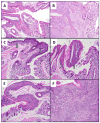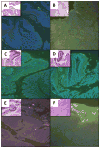The role of pharmacologic modulation of autophagy on anal cancer development in an HPV mouse model of carcinogenesis
- PMID: 28431282
- PMCID: PMC5584602
- DOI: 10.1016/j.virol.2017.04.007
The role of pharmacologic modulation of autophagy on anal cancer development in an HPV mouse model of carcinogenesis
Abstract
Autophagy is an intracellular, catabolic process that maintains cellular health. We examined the response of pharmacologic modulation of autophagy in an HPV mouse model of anal carcinogenesis. K14E6/E7 mice were treated with the topical carcinogen DMBA weekly and assessed for tumors over 20 weeks. Concurrently, they were given either chloroquine or BEZ235, to inhibit or induce autophagy, respectively. Time to tumor onset was examined. Immunofluorescence (IF) was performed for LC3β and p62 to examine autophagy. All DMBA treated K14E6/E7 mice developed anal cancer, contrary to zero of the no DMBA treated mice. Chloroquine plus DMBA resulted in a significant decrease in the time to tumor onset compared to K14E6/E7 treated with DMBA. Only 40% BEZ235 plus DMBA treated mice developed anal cancer. Autophagic induction with DMBA and BEZ235, and autophagic inhibition with chloroquine were confirmed via IF. Anal carcinogenesis can be inhibited or induced via pharmacologic modulation of autophagy.
Keywords: Anal cancer; Anal dysplasia; Autophagy; BEZ235; Chemoprevention; HPV.
Copyright © 2017 Elsevier Inc. All rights reserved.
Figures








Similar articles
-
Topical application of a dual PI3K/mTOR inhibitor prevents anal carcinogenesis in a human papillomavirus mouse model of anal cancer.Eur J Cancer Prev. 2019 Nov;28(6):483-491. doi: 10.1097/CEJ.0000000000000505. Eur J Cancer Prev. 2019. PMID: 30888976 Free PMC article.
-
Dysregulation of Autophagy Contributes to Anal Carcinogenesis.PLoS One. 2016 Oct 5;11(10):e0164273. doi: 10.1371/journal.pone.0164273. eCollection 2016. PLoS One. 2016. PMID: 27706233 Free PMC article.
-
PI3K/mTOR inhibition prevents anal cancer in mice with established low-grade anal dysplasia.Exp Mol Pathol. 2022 Apr;125:104752. doi: 10.1016/j.yexmp.2022.104752. Epub 2022 Feb 18. Exp Mol Pathol. 2022. PMID: 35183509 Free PMC article.
-
The Human Papillomavirus Vaccine: Current Perspective and Future Role in Prevention and Treatment of Anal Intraepithelial Neoplasia and Anal Cancer.Oncologist. 2016 Apr;21(4):453-60. doi: 10.1634/theoncologist.2015-0075. Epub 2016 Mar 9. Oncologist. 2016. PMID: 26961923 Free PMC article. Review.
-
Human Papillomavirus and Genital Warts: A Review of the Evidence for the 2015 Centers for Disease Control and Prevention Sexually Transmitted Diseases Treatment Guidelines.Clin Infect Dis. 2015 Dec 15;61 Suppl 8:S849-55. doi: 10.1093/cid/civ813. Clin Infect Dis. 2015. PMID: 26602622 Review.
Cited by
-
Mechanism of anticancer effect of gambogic acid on gastric signet ring cell carcinoma.Med Oncol. 2023 Aug 16;40(9):269. doi: 10.1007/s12032-023-02149-9. Med Oncol. 2023. PMID: 37587317
-
Topical Protease Inhibitor Decreases Anal Carcinogenesis in a Transgenic Mouse Model of HPV Anal Disease.Viruses. 2023 Apr 20;15(4):1013. doi: 10.3390/v15041013. Viruses. 2023. PMID: 37112993 Free PMC article.
-
HIV-1 Protease Inhibitors Slow HPV16-Driven Cell Proliferation through Targeted Depletion of Viral E6 and E7 Oncoproteins.Cancers (Basel). 2021 Feb 24;13(5):949. doi: 10.3390/cancers13050949. Cancers (Basel). 2021. PMID: 33668328 Free PMC article.
-
Differences of basic and induced autophagic activity between K562 and K562/ADM cells.Intractable Rare Dis Res. 2017 Nov;6(4):281-290. doi: 10.5582/irdr.2017.01069. Intractable Rare Dis Res. 2017. PMID: 29259857 Free PMC article.
-
Topical application of a dual PI3K/mTOR inhibitor prevents anal carcinogenesis in a human papillomavirus mouse model of anal cancer.Eur J Cancer Prev. 2019 Nov;28(6):483-491. doi: 10.1097/CEJ.0000000000000505. Eur J Cancer Prev. 2019. PMID: 30888976 Free PMC article.
References
Publication types
MeSH terms
Substances
Grants and funding
LinkOut - more resources
Full Text Sources
Other Literature Sources
Medical
Miscellaneous

